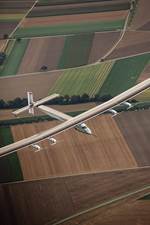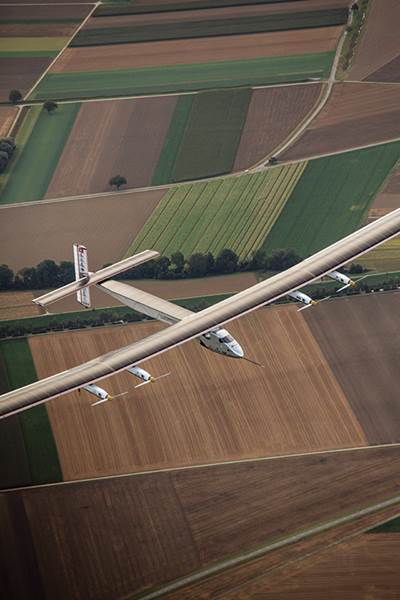Round-the-world flight progress: Solar Impulse 2
Energized only by sunlight taken in by the solar panels arrayed on its horizontal surfaces, the electric-prop-driven, all-composite-airframed Solar Impulse (Si2) aircraft had completed nearly one-half of its much publicized ŌĆśround- the-world trip as CWŌĆÖs May issue went to press.
Energized only by sunlight taken in by the solar panels arrayed on its horizontal surfaces, the electric-prop-driven, all-composite-airframed Solar Impulse (Si2) aircraft had completed nearly one-half of its much publicized ‘round- the-world trip as CW’s May issue went to press. It took off the morning of March 9 on the first leg from Abu Dhabi, UAE, under the watchful eyes of the Solar Impulse team there and its Mission Control Center in Monaco. Andre╠ü Borschberg lifted off in Si2 at 7:12 a.m. (GMT +4) on Monday, carrying no backup fuel supply or alternative means of propulsion, headed for Muscat (Oman) before crossing the Arabian Sea to Ahmedabad (India) on the first leg of what
is intended to be a round-the-world flight. Borschberg’s partner and the aircraft’s co-developer, Bertrand Piccard, took the controls in Oman and continued on to Ahmedabad. Piccard and Borschberg have since alternated as pilots of the single-seater experimental solar aircraft, completing three additional legs of its world tour. Si2 took off for its fourth flight on March 18, piloted by Piccard, from Varanasi (Lal Bahadur Shastri Airport) in the Republic of India, to Mandalay International Airport in the Republic of the Union of Myanmar, landing at 23:52 UTC (see photo). Piccard flew the airplane about 1,408 km for about 20 hours.
At CW press time, the Si2 Team was about to embark on leg 6, from Chongqing, China to
Nanjing, China, which had been delayed by poor weather. Assuming a successful flight to
Nanjing, the next leg is a much more ambitious, nonstop flight from China to Hawaii.
The Solar Impulse company noted, on the occasion of the event, that it has taken 12 years for Piccard (the development program’s initiator and chairman) and Borschberg (founder and CEO), to reach the point where they could demonstrate in such a fashion the importance of renewable energy.
Capable of flying over oceans for several days and nights in a row, Solar Impulse is scheduled, during the RTW trip, to travel a total of 35,000 km in 25 days over the course of roughly five months. Piccard and Borschberg are required to demonstrate extraordinary endurance in a 3.8m3 unpressurized, unheated cockpit, with external temperatures ranging from -40°C to +40°C. Si2 has successfully passed over the Arabian Sea, India and Myanmar. After reaching China and negotiating the Pacific Ocean with a stopover in Hawaii and an Americas leg, it will cross the Atlantic Ocean — the lengthy ocean crossings are expected to be the technology’s greatest tests and the adventure’s highlights. The final legs include a stopover in Southern Europe or North Africa before completing the round-the- world flight at its final destination in Abu Dhabi, Solar Impulse’s official host city. During scheduled stops, the Solar Impulse team and its partners have held and will hold public events.
Supported by Prince Albert of Monaco, UAE Minister of State and Chairman of Masdar H.E. Dr. Sultan Al Jaber, Richard Branson and Al Gore, the #FutureIsClean initiative has been launched on to recruit support for the adoption of clean technologies worldwide. Of the challenge, Piccard and Borschberg have said: “We are very ambitious in our goal, but modest, given the magnitude of the challenge. This is an attempt, and only time will tell if we can overcome the numerous weather, technical, human and administrative issues.”
Solar Impulse is an airborne laboratory, made from technological solutions developed by a team of 80 specialists and more than 100 partners and consultants. Si2 is the largest aircraft ever built with such a low weight, equivalent to that of a small car. With a wing larger than that of a Boeing 747 covered by more than 17,000 solar cells, the plane can fly up to an altitude of 8,500m at 50-100 kmh.
Related Content
Development of a composite liquid hydrogen tank for commercial aircraft
Netherlands consortium advances cryogenic composites testing, tank designs and manufacturing including AFP, hybrid winding, welding of tank components and integrated SHM and H2 sensors for demonstrators in 2025.
Read MoreLow-cost, efficient CFRP anisogrid lattice structures
CIRA uses patented parallel winding, dry fiber, silicone tooling and resin infusion to cut labor for lightweight, heavily loaded space applications.
Read MoreFirst Airbus A350 crash confirmed in Haneda
Shortly after touch-down, a JAL A350-900 aircraft recently collided with a De Havilland Canada Dash 8. Exact circumstances are still unknown.
Read More“Structured air” TPS safeguards composite structures
Powered by an 85% air/15% pure polyimide aerogel, Blueshift’s novel material system protects structures during transient thermal events from -200°C to beyond 2400°C for rockets, battery boxes and more.
Read MoreRead Next
Spread-tow technology takes off
New, ultralight-areal-weight prepreg tapes form the thin-ply laminates will enable Solar Impulse 2ŌĆÖs sun-powered flight around the world.
Read MoreCeramic matrix composites: Faster, cheaper, higher temperature
New players proliferate, increasing CMC materials and manufacturing capacity, novel processes and automation to meet demand for higher part volumes and performance.
Read MoreUltrasonic welding for in-space manufacturing of CFRTP
Agile Ultrasonics and NASA trial robotic-compatible carbon fiber-reinforced thermoplastic ultrasonic welding technology for space structures.
Read More











